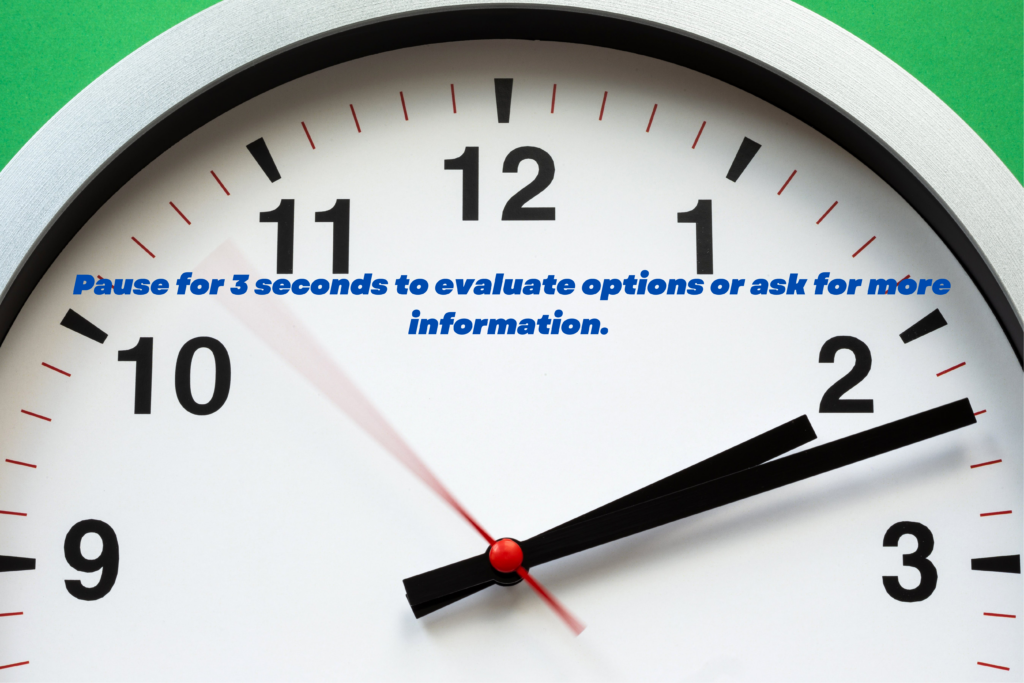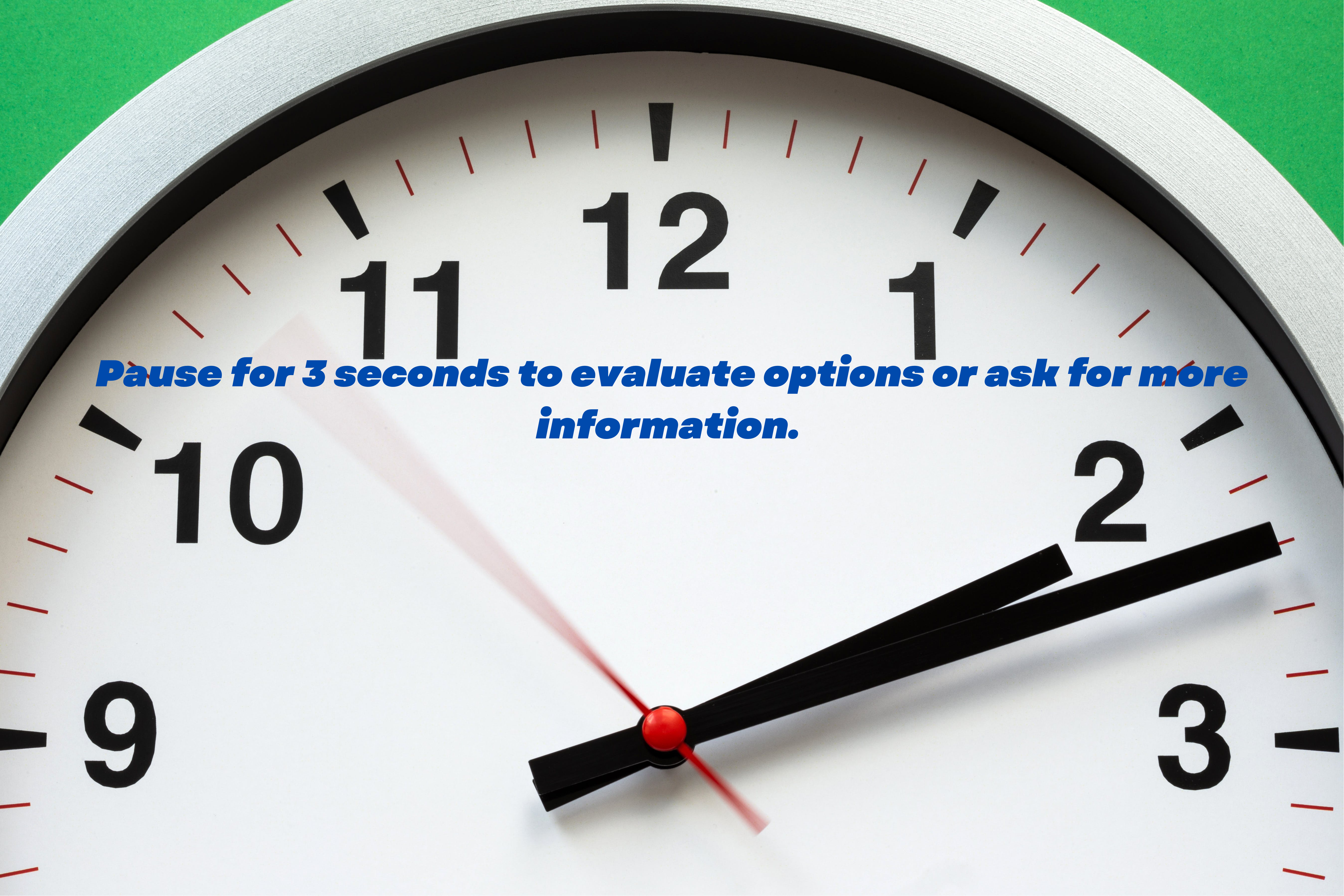Estimated reading time: 6 minutes
Table of contents
- Body Language and the Three-Second Rule
- Good Deal vs. Great Deal
- Good Negotiators and the Three-Second Rule
- Powerful Tool for Decision Making
- Different Ways to Use the Three-Second Rule
- Black Swans
- The First Offer
- The Negotiating Table and the Three-Second Rule
- The Best Way to Use the Three-Second Rule
- The Bottom Line
- Mel Robbins
- Win-Win Outcomes and the Three Second Rule
- Extreme Cases
- Professional Negotiators
- Potential Customers
- In Conclusion
What is the Three-Second Rule? This is a communication technique that encourages us to pause for three seconds before responding to someone’s statement or question.
This pause allows us to gather our thoughts, evaluate the situation, and choose an appropriate response.
The Three Second Rule can be applied in various situations, from everyday conversations to professional negotiations.
Read a related article about sales professionals: Here
Body Language and the Three-Second Rule
Body language is a powerful tool in negotiation. It can convey our confidence, sincerity, and overall demeanor.
The Three-Second Rule can help us to use body language effectively by giving us time to read the other person’s non-verbal cues and adjust our own body language accordingly. For example, we can use pregnant pauses or open questions to encourage the other party to share more information or to clarify their position.
[divi_switch_layout id=”1311″]
Good Deal vs. Great Deal
Negotiators who master the Three-Second Rule are more likely to achieve great deals instead of settling for good deals.
This is because the Three-Second Rule helps us to identify and address the underlying interests and priorities of both parties. By doing so, we can create win-win outcomes that benefit everyone involved.
Ray Dalio was a master negotiator and Deal maker, Bridgewater, the world’s largest fund.
Read a related article about Ray Dalio: Here
Good Negotiators and the Three-Second Rule
Good negotiators know how to use the Three-Second Rule to their advantage.
They understand the importance of active listening, empathy, and calibrated questions.
Active listening involves giving the other party our undivided attention and acknowledging their feelings and concerns.
Empathy involves putting ourselves in the other party’s shoes and trying to understand their perspective.
Calibrated questions are open-ended questions that encourage the other party to share more information and clarify their position.

Powerful Tool for Decision Making
The Three-Second Rule can also help us to make better decisions in negotiation. By pausing for three seconds before responding, we can avoid impulsive or emotional responses that may not serve our best interests.
We can also take the time to evaluate the potential consequences of our decisions and choose the best course of action.
Different Ways to Use the Three-Second Rule
The Three-Second Rule can be used in different ways depending on the negotiation context.
For example, we can use it to pause before responding to the other party’s first offer, to evaluate different options, or to ask for more information.
The key is to use the Three-Second Rule intentionally and strategically, rather than as a habit loop.

Black Swans
Black swans are unexpected or unforeseeable events that can disrupt the negotiation process. The Three Second Rule can help us to respond to black swans in a calm and measured way, rather than reacting impulsively.
By pausing for three seconds, we can gather our thoughts, assess the situation, and choose the best course of action.
The First Offer
The first offer in a negotiation can set the tone for the rest of the negotiation process.
The Three-Second Rule can help us to respond to the first offer in a way that aligns with our own goals and interests.
By pausing for three seconds, we can evaluate the offer, ask calibrated questions, and make a counteroffer that reflects our own interests.
The Negotiating Table and the Three-Second Rule
The negotiating table can be a stressful and high-pressure environment. The Three-Second Rule can help us to stay calm and focused by giving us time to evaluate the situation and choose our responses carefully.
By pausing for three seconds, we can also demonstrate our confidence and professionalism to the other party.
The Best Way to Use the Three-Second Rule
The best way to use the Three-Second Rule is to practice it regularly and intentionally. We can start by using the Three Second Rule in everyday conversations and gradually apply it to more complex negotiation settings.
We can also combine the Three Second Rule with other negotiation skills such as active listening, empathy, and calibrated questioning for the best results.
The Bottom Line
The bottom line is the minimum outcome we are willing to accept in a negotiation. The Three Second Rule can help us to communicate our bottom line effectively by giving us time to choose our words carefully and convey our position clearly.
By pausing for three seconds, we can also assess the other party’s response and adjust our position accordingly.
Related article about Leadership: Here
The Bottom Line is the minimum outcome we are willing to accept in a negotiation.
Mel Robbins
Mel Robbins is a motivational speaker and author who popularized the Three Second Rule in her book “The 5 Second Rule“.
According to Robbins, the Three Second Rule can help us to break habit loops, overcome procrastination, and take action towards our goals.
While the Three Second Rule can be applied in different contexts, its core principles remain the same: pausing for three seconds, gathering our thoughts, and taking intentional action.
Win-Win Outcomes and the Three Second Rule
Win-win outcomes are outcomes that benefit both parties in a negotiation.
The Three Second Rule can help us to create win-win outcomes by encouraging us to listen actively, understand the other party’s interests and priorities, and find creative solutions that satisfy both parties.
By using the Three Second Rule, we can avoid positional bargaining and focus on creating value for everyone involved.
Extreme Cases
In extreme cases, such as negotiations involving unfair labor practices or non-permissive subjects, the Three Second Rule can help us to stay calm and focused.
By pausing for three seconds, we can gather our thoughts, evaluate our options, and choose the best course of action.
We can also use the Three Second Rule to avoid emotional responses that may escalate the situation and prevent us from achieving our goals.
Professional Negotiators
Professional negotiators use the Three Second Rule as part of their negotiation skills toolkit. They understand that negotiation is a complex process that requires careful planning, active listening, and effective communication.
By using the Three Second Rule, they can communicate their position clearly, assess the other party’s response, and find creative solutions that satisfy both parties.
Potential Customers
The Three Second Rule can also be used in sales negotiations with potential customers. By pausing for three seconds before responding to objections or questions, we can demonstrate our confidence, professionalism, and expertise.
We can also use the Three Second Rule to evaluate the customer’s needs and preferences, and offer tailored solutions that meet their requirements.
In Conclusion
The Three Second Rule is a simple yet powerful tool that can help us to navigate negotiations with confidence, clarity, and professionalism.
By pausing for three seconds before responding, we can gather our thoughts, evaluate the situation, and choose the best course of action.
We can also combine the Three Second Rule with other negotiation skills such as active listening, empathy, and calibrated questioning for the best results.
Whether we are negotiating with colleagues, clients, or potential customers, the Three Second Rule can help us to achieve our goals and create win-win outcomes.

